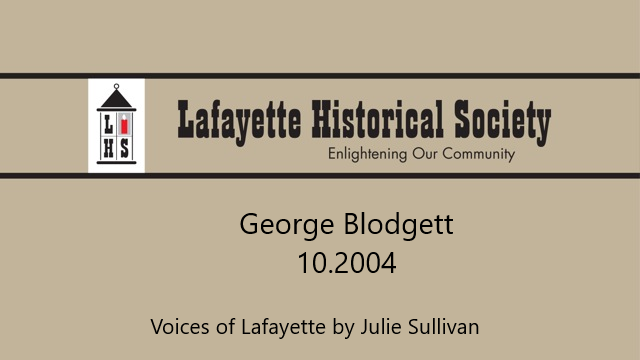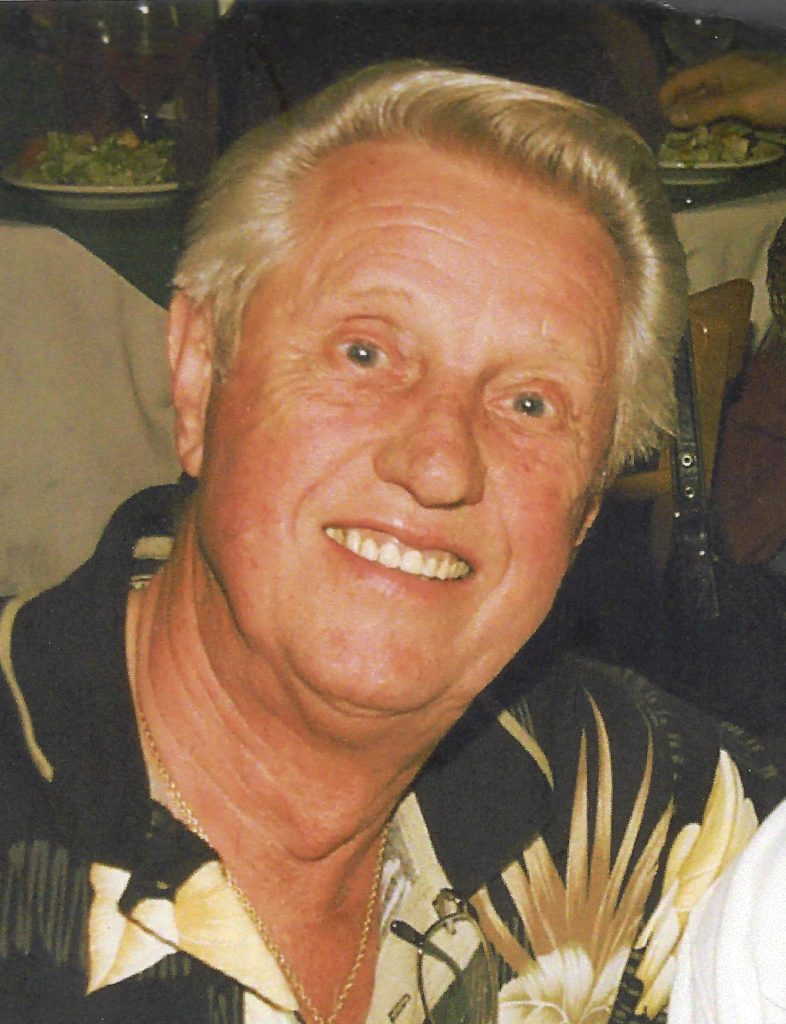Summary:
George Blodgett was twelve years old in 1946 when his father Kermit founded Blodgett’s Linoleum. His father also purchased land off Reliez Valley Road, then put in Vaughn Road, and developed homes for his family and others. Eleven years later George joined the business, expanding it to offer carpeting in addition to other floor coverings. Today, after nearly eight decades of growth and change in Lafayette, the business still thrives under the management of George’s son Larry, an architect with experience in building construction.
Oral History:
“We have one of the oldest contractor’s licenses in this area – fifty-eight years,” George Blodgett says proudly. “My father, Kermit, started Blodgett’s Linoleum in 1946, and now my son, Larry, has taken it over. We’ve had three generations in the floor business. Lafayette has had four or five full service floor covering stores come and go, and Blodgett’s is still there.”
George credits his father with much of Bodgett’s success. “My father was a visionary, a salt of the earth type guy. Everything he did he did by the sweat of his brow.”
Kermit and his wife moved to Lafayette with their daughter, Joan and son, two-year-old George, in 1936. “That was the year they opened the tunnel. But they didn’t call it the Caldecott,” George adds. “They called it the Broadway Low Level Tunnel.” Kermit was running a grocery store in Berkeley when he and his best friend, George Wallace, bought a 10-acre parcel off Reliez Valley Road with two houses on it. “That’s how I got the name George. When George wanted to move in 1946, they subdivided the property into two parcels. George sold his and my dad bought several more acres, put in Vaughan Road, and built another house. “My dad never had anything easy. Life to him was one struggle after another. He got into financial trouble because of the Depression and had to close the grocery store. He ran a credit store, and I remember him going through his bureau drawers and finding a bunch of checks that he never cashed. Around 1940 he was working for Oakland Plumbing Supply, wrestling cast iron pipes and bathtubs around.
“At that time we had a farmer’s phone line with two wires. It was called the Brookwood Rural Telephone Company. One of the neighbors on our line was in the linoleum business, and my father went to work for him as an apprentice. After seven or eight months he was a journeyman, but in 1941 his boss closed the business down after he joined the Seabees, so my dad was without a job again.” Kermit found work in the Kaiser shipyards in Richmond, but because of a persistent cough agreed to his wife’s urging to quit.
“While he was at the shipyards he drove our Model A Ford to Sacramento and took the test for his contractors’s license, George says. “He started the business in 46 and suffered through the first year or two.” None of the wholesalers would sell linoleum to Kermit because it was wartime, and as a new business owner he had no allotment and no established credit. Kermit flew to Los Angeles, where George’s uncle knew a man who had a surplus supply. “My dad bought a whole roll, used what he needed to lay the floor in my uncle’s place, then shipped the rest back here via Railway Express.”
Finally, one of the wholesalers issued Kermit credit. He rented a storefront on Mt. Diablo Boulevard where Armand’s Drapery Studio is now and operated the business from there until the mid-1950’s. George graduated from San Francisco State University in marketing in 1956 and was married to the former Lou Thompson in 1957. They have two children, a son and a daughter. George traveled Northern California selling vinyl asbestos tile, cork tile and high pressure laminate. Around 1957 he joined Kermit in the business.
“I laid floors, then made estimates in the afternoon until 7:00 or 8:00 p.m.
That was in the days when Micarta made by GE was just coming on the market,” George remembers. “Formica wasn’t in business yet, but Micarta was like it. My dad didn’t know how to work it. It was like glass. He started putting it on counter tops. But he didn’t do anything the easy way. He had no power tools. He cut it with his linoleum knife then broke it. When he put in a sink, he had to under scribe the bowl, then cut the Micarta and hope it fit. He’d file it and glue it onto the board. That’s the way it was for many, many years.
“The business became so mechanized we had to start buying electrical tools. My dad bought a kett saw. It was a little attachment on a Milwaukee electric drill and had a saw blade about an inch and a quarter diameter, and that’s what he’d cut the Formica with. Nowadays everything is done with routers.
“When I got out of college my dad asked me to build a rental house on his property. I dug the ditches, put in the steel, did the wiring, the cabinets, the floors, the fireplace, and put the roof on. When the tenants moved out and I came to work for him, he let me rent it for a good price. Today I live on the same property in a different house I designed and helped build on Vaughan Road, named for Professor Vaughan, a language teacher at Cal.
“We had a chance to buy the building on Mt. Diablo where our store was, but it would have been more expensive than what my dad eventually decided to do,” George explains. “We always closed the store at noon on Saturdays, then my mother and father and I went to lunch and had a business conference. We were on our way to the Tunnel Inn, where that big eucalyptus tree is next to the brick building that used to house Freddie’s Pizza, when we saw Russ Bruzzone, a good client of ours. There were two houses on top of a hill he was going to knock down. Russ said we could have them for two hundred dollars a piece. We stopped at Howard Fold’s real estate office to see if we could find a vacant lot close to town. He didn’t have any, but he knew of a commercial lot Clarence and Frieda Brown owned on Norton Drive. Old Tunnel Road swooped down off of Rt. 24 and Norton Drive was just a little short street between them.
“My dad got Clarence to sell him the lot and subordinate the property. This was in the days where a handshake was all you needed to make a contract. We bought the houses and the lot and had A. N. House Movers roll them down Mt. Diablo Boulevard on a dolly. I thought we would tear all the interior walls out of the houses and convert them to a store, but my dad said ‘I think we can jack the houses up and build a store under them.
“We got an architect and drew up the plans and got some builders to reinforce the floor in one of the buildings. They worked underneath the house and put bigger joists under the floor. We built a little Formica shop and a linoleum shop under the houses, and my mom and dad lived upstairs in one house and my grandmother lived in the other one until she passed on. We were in there for a couple of years. Route 24 was being expanded to become a full freeway, and they were going to take our store for the interchange.
“Then my dad was on the hunt for some property again. He bought the property where our store is now, 3291 Mt. Diablo Boulevard, in the late 50’s or early 60’s. I asked an architect who was the father of a friend of mine to design our new building. We have only made one addition on the building, a little warehouse in front. We have about 8,100 square feet and plenty of parking.
“My father was born out in the Plains in South Dakota, and he always liked to farm. He loved to get his hands in the dirt. Out in front of the store is a vacant lot that is not a buildable site. He asked the original city manager if he could plant vegetables out there, and he was told to go ahead. He’d get manure in and rototill it, and the newspaper ran a picture of him standing in the middle of a corn field in front of the store. He grew pumpkins there one year.
“My father and mother were married forty years when she passed away. He married Isabel Brown and they were married nineteen years. My father retired the day he turned sixty-five. He came to work in 1974 and said, ‘Today is my birthday and Isabel and I are going to drive to Los Angeles.’ He died when he was eighty-two.”
George made changes to the business even before Kermit retired. “I was a partner without any agreement. My father didn’t believe in partnerships, because too many of them failed. I got my father started in the carpet business. The bigger manufacturers were very protective of who could get their franchises. I bought an Abbey carpet franchise, which required a certain dollar level of overall business, plus integrity and a good reputation. In those days you could get carpet samples in books for free. I worked out my own display system. I took the books apart and put suspender clips on the samples and drilled holes in house doors and hung them on the doors.”
George also began the practice of asking for a deposit on all orders. “And I made sure we made out purchase orders. You have to be very careful you only order something once.” The first three years George worked seven days a week, about 14 hours a day. Later on he took Sundays off, but often spent the day costing jobs. His wife, Lou, worked part-time. When George retired in 1996 Blodgett’s employed two people in the office, from four to seven installers, and two Formica fabricators.
Larry, George’s son, joined the business as a salesman after earning a degree in architecture from the University of Idaho. Larry still does architectural work, and one of the houses he designed in Walnut Creek was featured in Sunset Magazine.
George remembers Lafayette as “Just a little podunk town.” When he was a teenager he walked from Lafayette to Walnut Creek to go to the movies. “It was five miles each way. During the war maybe one or two cars would pass me all that way. There was the ‘T’ at St. Mary’s and Moraga Road. I remember riding my horse in the rodeo parade. Bill and Marie’s coffee shop and the Associated gas station was where World Savings (now Wachovia) is. Where the Union Station is today there was an adobe building that was built for a home then turned into a restaurant. It was called Pinky’s. Then Pop Luce took it over for a while. Jennings was a blacksmith, a modern day blacksmith. He had the Forge at the corner of Brown Ave. and Mt. Diablo where Kaffee Barbara is now.
“Lafayette is a strip town, not a quaint little village,” George adds. “It’s a nice little town. People are friendly. A lot of working stiffs used to have houses here, 900-1000 square feet. People lived here till they died.”
Excerpted from “Voices of Lafayette” by Julie Sullivan. This book is available for purchase in the History Room.



Leave a Reply